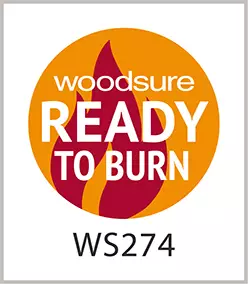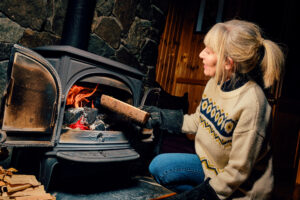Want to know how to light a log burner AND keep it going for maximum efficiency and heat output? You’re in the right place. If you’ve recently joined the ranks of log burner users, welcome aboard! You’re certainly in for a treat! In this guide, we’ll walk you through everything you need to know about how to start a log fire and keep it going with maximum efficiently.
From choosing the best logs to use in your log burner, how to prepare your log burner for lighting, and maintaining the perfect temperature, we’ll have you firing up the feel good in no time!
So let’s get started!
Step 1) Choosing the Best Logs for Your Log Burner
The first step to building a successful and efficient log fire is choosing the right type of firewood. For the best fire lighting results, do the following:
 1. Always buy Woodsure Ready To Burn Logs: The Woodsure Ready To Burn certification ensures that certified logs have been dried to a moisture content of 20% or less, and have the right moisture content for efficient combustion. Ready To Burn certified logs, like ours, ensure your logs are suitable for immediate use.
1. Always buy Woodsure Ready To Burn Logs: The Woodsure Ready To Burn certification ensures that certified logs have been dried to a moisture content of 20% or less, and have the right moisture content for efficient combustion. Ready To Burn certified logs, like ours, ensure your logs are suitable for immediate use.
2. Buy Kiln Dried Hardwood Logs to keep your fire going: Hardwood logs are a popular choice for log burners because they burn hotter and last longer. When dried to around 20% moisture or less, Ash, oak, and beech are the best species for use in log burners as they provide a slow and steady burn with a high heat output – making them ideal for long, clean and efficient burning.
3. Buy Kiln Dried Softwood Logs to build your fire and raise stove temperatures: Softwood logs such as pine, fir or spruce, are ideal for lighting fires and raising log burner temperatures quickly to allow kiln dried hardwood logs to effectively combust. After all, trying to light hardwood logs in a cool stove is a bit like trying to light a brick!. That’s why softwood logs are no better or worse than hardwood logs. They just offer different benefits!
BLOG: Hardwood versus softwood logs: what’s better for burning?
Step 2) Preparing your log burner
Once you’ve got a stash of logs that are ready for immediate use, it’s time to prepare your log burner for lighting. To get started, follow these steps:
 1. Add kindling to a bed of ash: Grab a a generous handful of kindling and place at the bottom of your log burner. Ideally, place your kindling on a bed of ash that’s accumulated from previous log fires.
1. Add kindling to a bed of ash: Grab a a generous handful of kindling and place at the bottom of your log burner. Ideally, place your kindling on a bed of ash that’s accumulated from previous log fires.
Why burn on a bed of ash? Ash acts as an insulator and helps to retain and distribute heat evenly – which helps to raise your log burner’s temperature more efficiently.
2. Open the Air Vents: Ensure the air vents are fully open to create sufficient air flow – an essential ingredient for firewood combustion.
BLOG: Top tips if you’re struggling to light your log burner
Step 3) How to start a log fire and keep it going
Lighting a log fire can seem a bit of an art at first, but with patience and practice, you’ll become a log burning pro in no time! Follow these steps to get your log fire started:
 1. Light the Firelighters: Ideally use a long lighters or matches to ignite the firelighters and nestle them into your nest of kindling.
1. Light the Firelighters: Ideally use a long lighters or matches to ignite the firelighters and nestle them into your nest of kindling.
Our natural firelighters dipped in natural paraffin wax are made from certified sustainably sourced wood wool and hold their flame long enough to get your fire blazing. And…they smell de-light-ful too!
2. Gradually Add Kiln Dried Softwood Logs: When the kindling is blazing away and the smoke is rising up the flue, add kiln dried softwood logs to build your fire up and raise your appliance’s temperature. Always start with smaller logs and add larger ones as your fire builds energy.
DID YOU KNOW…
In cold weather, it’s harder to start a log fire: Log fires can be tricky to get going when it’s cold and damp outside. The reason is a phenomenon called “Cold Chimney Syndrome,” which happens because cold air gets stuck in the chimney, making it harder for your fire to draw air and burn effectively.
Solution: To fix this issue, take some extra time to warm up your stove before adding more logs. This ensures that the smoke rises up the chimney properly, making your fire building more effective.
2. Add Kiln Dried Hardwood Logs to sustain the burn: Once your log fire is roaring away and your stove’s temperature has reached around 300 degrees Celsius, add kiln dried hardwood logs to sustain the burn. This is when time and patience is key, because adding hardwood logs to an appliance that isn’t quite hot enough is a bit like trying to light a brick!
DID YOU KNOW? Even kiln dried hardwood logs will smoke and smoulder if your appliance hasn’t reached optimal combustion temperatures. Kiln dried logs will only combust in the right conditions.
TOP TIP: Buy a stove thermometer to gauge your log burner’s temperature
3. Keep an Eye on the Air Vents: Adjust the air vents as needed to control the fire’s intensity. Opening them wide allows for more oxygen and a hotter fire, while closing them slightly slows the burn rate. We suggest slowly closing down the air vents when your fire is well established and you’re ready to kick back, relax and enjoy that log fire you just built!
Step 4) Maintaining your log burner’s temperature
Maintaining optimal log burner temperatures is crucial for maximising log burning efficiency as well as safety. Here are some useful tips:
 1. Use a Wood Moisture Meter: Invest in a wood moisture meter to ensure the logs you’re using have a moisture content of around 20% or less. Logs sold with the Woodsure Ready To Burn logo, like ours, is the best trust signal to ensure your logs are ready for immediate use.
1. Use a Wood Moisture Meter: Invest in a wood moisture meter to ensure the logs you’re using have a moisture content of around 20% or less. Logs sold with the Woodsure Ready To Burn logo, like ours, is the best trust signal to ensure your logs are ready for immediate use.
2. Regularly Clean the Burner: Empty the ash pan regularly to maintain good airflow from your appliance.
3. Monitor the Flue Temperature: You can use a flue thermometer to monitor the temperature of the flue gases. Aim for a temperature of around 250-450°C for the most efficient and clean burn.
4. Close the Air Vents When Not in Use: When you’re not using your log burner, close the air vents to prevent heat from escaping through the chimney.
PRO TIP: Keep your stove door slightly ajar when it’s not in use. That way, some room temperature air will draw up the flue and help it to stay warm and aid combustion when lighting.
To sum up our log burning advice…
By following this log burning advice, you’ll be able to enjoy the warmth, comfort, and ambiance it provides. Just be sure to always follow safety guidelines and check your local regulations for using log burners, especially if you’re new to using one.
And with some practice and patience, you’ll soon become a log burning master and create cosy fires that provide comfort and warmth on even the coldest of days.
Happy burning!
Read more of our handy log burning blogs!
Follow us!
Be the first to hear about our offers, wood burning advice and so much more!
Burn it. Love it. Tag it! #TheLogPeople

0 Comments